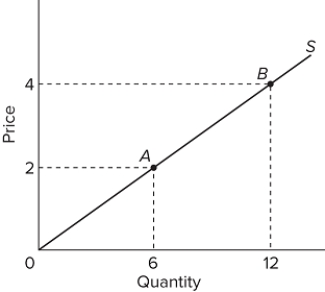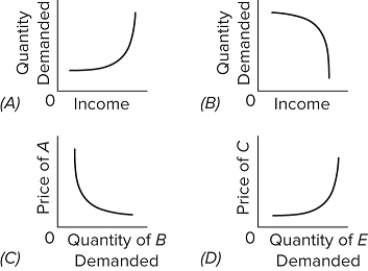A) perfectly price elastic.
B) of unit price elasticity.
C) relatively price inelastic.
D) relatively price elastic.
Correct Answer

verified
Correct Answer
verified
Multiple Choice
Suppose that a firm has "pricing power" and can segregate its market into two distinct groups based on differences in elasticities of demand. The firm might charge
A) a lower price to the group that has the less elastic demand.
B) a higher price to the group that has the less elastic demand.
C) the same price to both groups but include a "free" related product for the group that has an inelastic demand.
D) the same price to both groups but make it difficult for the group with the more elastic demand to gain access to the product.
Correct Answer

verified
Correct Answer
verified
Multiple Choice
 Refer to the data. Suppose quantity supplied declined by 23 units at each price, changing the equilibrium price in a direction and amount for you to determine. Over that price range, demand is
Refer to the data. Suppose quantity supplied declined by 23 units at each price, changing the equilibrium price in a direction and amount for you to determine. Over that price range, demand is
A) elastic.
B) inelastic.
C) perfectly elastic.
D) perfectly inelastic.
Correct Answer

verified
Correct Answer
verified
Multiple Choice
 Refer to the above table. Which product is a normal good but least responsive to a change in income?
Refer to the above table. Which product is a normal good but least responsive to a change in income?
A) Product W
B) Product X
C) Product Y
D) Product Z
Correct Answer

verified
Correct Answer
verified
Multiple Choice
The price elasticity of demand for widgets is 0.4. Assuming no change in the demand curve for widgets, a 6 percent decrease in sales implies a(n)
A) 13.5 percent increase in price.
B) 18 percent increase in price.
C) 15 percent increase in price.
D) 2.4 percent increase in price.
Correct Answer

verified
Correct Answer
verified
Multiple Choice
 In the graph above, what would happen to price and to total revenue if the equilibrium moved from point B to point A?
In the graph above, what would happen to price and to total revenue if the equilibrium moved from point B to point A?
A) Price would fall and total revenue would increase.
B) Price would fall and total revenue would also decrease.
C) Price would rise and total revenue would also increase.
D) Price would rise and total revenue would decrease.
Correct Answer

verified
Correct Answer
verified
Multiple Choice
Elasticity of supply will increase when
A) the number of producers selling a product decreases.
B) producers are given less time to respond to price changes.
C) the number of consumers wanting to purchase a product increases.
D) it becomes easier to substitute one factor of production for another in a manufacturing process.
Correct Answer

verified
Correct Answer
verified
Multiple Choice
At a price of $4 per unit, Gadgets Inc. is willing to supply 20,000 gadgets, while United Gadgets is willing to supply 10,000 gadgets. If the price were to rise to $8 per unit, their respective quantities supplied would rise to 45,000 and 25,000. If these are the only two firms supplying gadgets, what is the elasticity of supply in the market for gadgets?
A) 1.2
B) 1
C) 0.83
D) 0.8
Correct Answer

verified
Correct Answer
verified
Multiple Choice
 Refer to the diagrams. The case of substitute goods is represented by figure
Refer to the diagrams. The case of substitute goods is represented by figure
A) A.
B) B.
C) C.
D) D.
Correct Answer

verified
Correct Answer
verified
True/False
Cross elasticity of demand measures the effect of a change in the price of one product on the quantity demanded of another product.
Correct Answer

verified
Correct Answer
verified
Multiple Choice
 Refer to the diagrams. In which case would the coefficient of income elasticity be negative?
Refer to the diagrams. In which case would the coefficient of income elasticity be negative?
A) A
B) B
C) C
D) D
Correct Answer

verified
Correct Answer
verified
Multiple Choice
Answer the question based on the following table, which shows a demand schedule.  Total revenues will decrease if price
Total revenues will decrease if price
A) rises from $1 to $2.
B) rises from $2 to $3.
C) rises from $3 to $4.
D) rises from $4 to $5.
Correct Answer

verified
Correct Answer
verified
Multiple Choice
The price of product X is reduced from $50 to $45 and, as a result, the quantity demanded increases from 120 to 140 units. Therefore, demand for X in this price range
A) has declined.
B) is of unit elasticity.
C) is inelastic.
D) is elastic.
Correct Answer

verified
Correct Answer
verified
Multiple Choice
Suppose that a 10 percent increase in the price of normal good Y causes a 20 percent increase in the quantity demanded of normal good X. The coefficient of cross elasticity of demand is
A) negative, and therefore these goods are substitutes.
B) negative, and therefore these goods are complements.
C) positive, and therefore these goods are substitutes.
D) positive, and therefore these goods are complements.
Correct Answer

verified
Correct Answer
verified
Multiple Choice
Suppose the price elasticity of supply for crude oil is 2.5. How much would price have to rise to increase production by 20 percent?
A) 8 percent
B) 12.5 percent
C) 20 percent
D) 45 percent
Correct Answer

verified
Correct Answer
verified
True/False
The price elasticity of supply determines how much price would change as a result of a change in demand.
Correct Answer

verified
Correct Answer
verified
Multiple Choice
You are the newly appointed sales manager of the Rock Computer Tablets Company and have been charged with the task of increasing revenues. Your economics consultants have informed you that at present price and output levels, price elasticity of demand for your product is less than one. You should
A) decrease prices.
B) increase prices.
C) hold prices constant and increase supply.
D) cut advertising expenditures to save money.
Correct Answer

verified
Correct Answer
verified
Multiple Choice
Answer the question based on the following table, which shows a demand schedule.  Total revenues will increase if price
Total revenues will increase if price
A) rises from $4 to $5.
B) falls from $3 to $2.
C) falls from $4 to $3.
D) rises from $1 to $2.
Correct Answer

verified
Correct Answer
verified
Multiple Choice
 Refer to the graphs above. Which one shows a perfectly elastic demand?
Refer to the graphs above. Which one shows a perfectly elastic demand?
A) graph A
B) graph B
C) graph C
D) graph D
Correct Answer

verified
Correct Answer
verified
Multiple Choice
We would expect
A) the demand for Coca-Cola to be less price elastic than the demand for soft drinks in general.
B) the demand for Coca-Cola to be more price elastic than the demand for soft drinks in general.
C) no relationship between the price elasticity of demand for Coca-Cola and the price elasticity of demand for soft drinks in general.
D) none of these answers hold true.
Correct Answer

verified
Correct Answer
verified
Showing 21 - 40 of 399
Related Exams